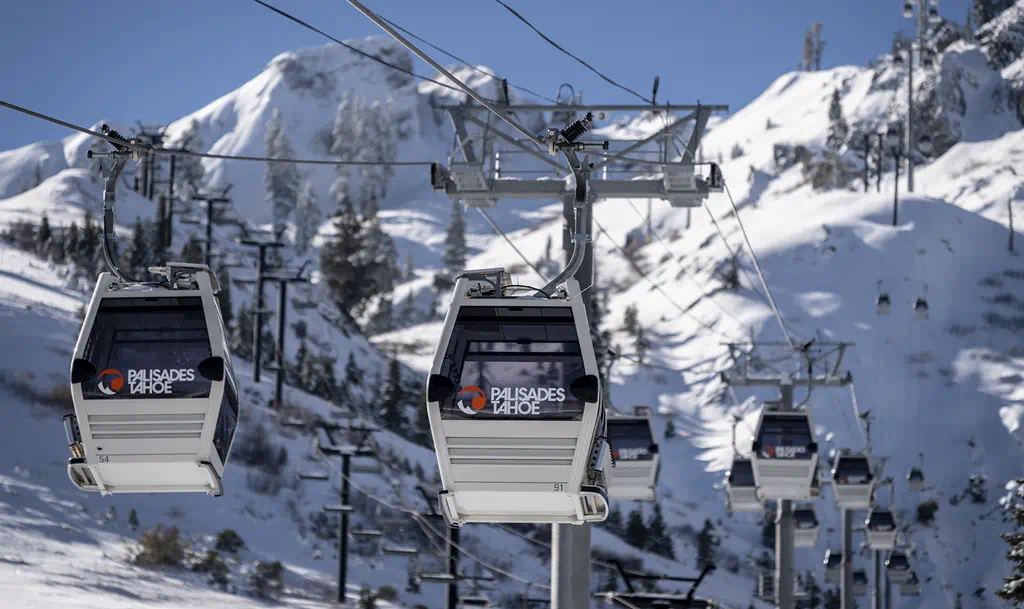The first of its kind in North America, the Base to Base Gondola connects the two base areas of Palisades Tahoe, finally uniting the resort. Guests will enjoy easy access to 6,000 acres of some of the continent’s most iconic ski and snowboard terrain. The Gondola transports guests between The Village at Palisades Tahoe and the Alpine Lodge, with the option for expert skiers and riders to unload at the KT-22 mid-station. The ride from The Village to Alpine takes about 16 minutes and allows guests to experience both mountains without adding vehicles on the road.

Gondola Stats
-
terminals
4 -
cabins
96 -
people per cabin
8 -
minute ride
16
The Base to Base Gondola connects the two valleys of the resort, making Palisades Tahoe the largest ski resort in California.
rich-text, responsive-tableThe length of the Gondola is 2.4 miles; it’s 1 mile from The Village at Palisades Tahoe base terminal to the KT mid-station and 1.4 miles from the Alpine Lodge base terminal to the KT mid-station.
rich-text, responsive-tableThe Gondola can be operated as one continuous lift or as two separate lifts from each base area to the top of KT-22.
rich-text, responsive-tableThe Gondola travels 1,870 vertical feet from The Village at Palisades Tahoe base terminal to the KT mid-station and 1,235 vertical feet from the Alpine Lodge base terminal to the KT mid-station.
rich-text, responsive-tableGondola FAQs
Where does the gondola go?
The Base to Base Gondola transports guests from The Village at Palisades Tahoe to the KT mid-station, where skiers and snowboarders will have the option to disembark. Sightseeing will not be allowed here. From the top of KT-22, the Gondola goes down through private land and cross another terminal where no disembarking is allowed. The Gondola then terminates in the Alpine base area, adjacent to the main lodge.
Is the Gondola open?
When does the gondola operate?
The Gondola will operate during the winter season only when both Palisades and Alpine are open. Its daily hours are 9am-4pm, weather and conditions permitting.
Does the gondola provide access to KT-22?
Yes, the Base to Base Gondola adds lift access to the top of the KT ridge, at the rate of 1,400 people per hour. KT-22 lift has an hourly capacity of 2,100. Access to KT-22 is for advanced/expert skiers and snowboarders only. No beginner or intermediate terrain is available from the top. Sightseeing guests are also not be allowed to disembark at the KT mid-station.
Is it possible to ski between Palisades and Alpine now that the gondola is installed?
No, the terrain at the two areas is not contiguous, and installation of the Base to Base Gondola does not open additional skiable terrain. Skiers and riders are able to use the Base to Base Gondola to travel between the two mountains rather than drive their vehicles. The trip takes about 16 minutes.
What is the name of the gondola?
The name of the Gondola is Base to Base Gondola.
Does the gondola impact the Granite Chief Wilderness?
The Base to Base Gondola does not cross into the Granite Chief Wilderness. It is about 1,100 feet (three football fields) from the Granite Chief Wilderness at its closest point. As part of an agreement reached with Granite Chief Wilderness Protection League, Palisades Tahoe provides funding, to be held in trust by the Truckee Donner Land Trust, for the acquisition of private holdings within the Granite Chief Wilderness Area and high resource value lands and/or conservation easements. Land eligible for purchase with the funds includes the area within and adjacent to the Granite Chief Wilderness.
How visible is the gondola be from surrounding areas? From the Five Lakes Trail?
The Gondola cable and towers are visible from the Five Lakes Trail as hikers move toward the top of the trail, and are visible to hikers as they leave the Wilderness, but there is very little visible impact once hikers have entered the Wilderness. The Gondola alignment through Catch Valley, which has steep topographical features on either side, results in its overall visibility being greatly reduced. The Gondola is not visible from Lake Tahoe.
During the summer months, cabins will be removed from the line and stored at the base terminals. Palisades Tahoe was also required to choose structure design, scale, color of materials, location, and orientation to reduce potential visual contrast. It is important to note that looking at or hiking the ridgeline between Palisades and Alpine, it is clear that on the Palisades side the Gondola is located within an existing ski resort. Specifically, the ridgeline has hosted the top terminal of the KT-22 and Olympic Lady lifts for decades. The peak of the Gondola is located near the top of KT-22, where there is already a visible lift. On the Alpine side, the towers from the incomplete White Wolf lift have been in place for over 20 years. Overall, the chosen project alignment is the least impactful to the ridgeline.
How did crews access the Gondola area for construction?
Construction access occurred almost entirely via existing roads and paths, and with use of helicopters to reduce or eliminate the need to build new access roads. As part of the project approvals, any road or path that was improved or extended for construction must be restored to its original condition after project completion.
Did new terrain open at Alpine because of the Gondola?
No. There is no new terrain opening at either Palisades or Alpine due to the Gondola. The Gondola acts as a connection between the two mountains, but it does not facilitate any new ski or snowboard access. The Alpine mid-station terminal will not allow any disembarking.

